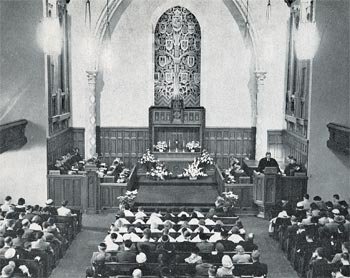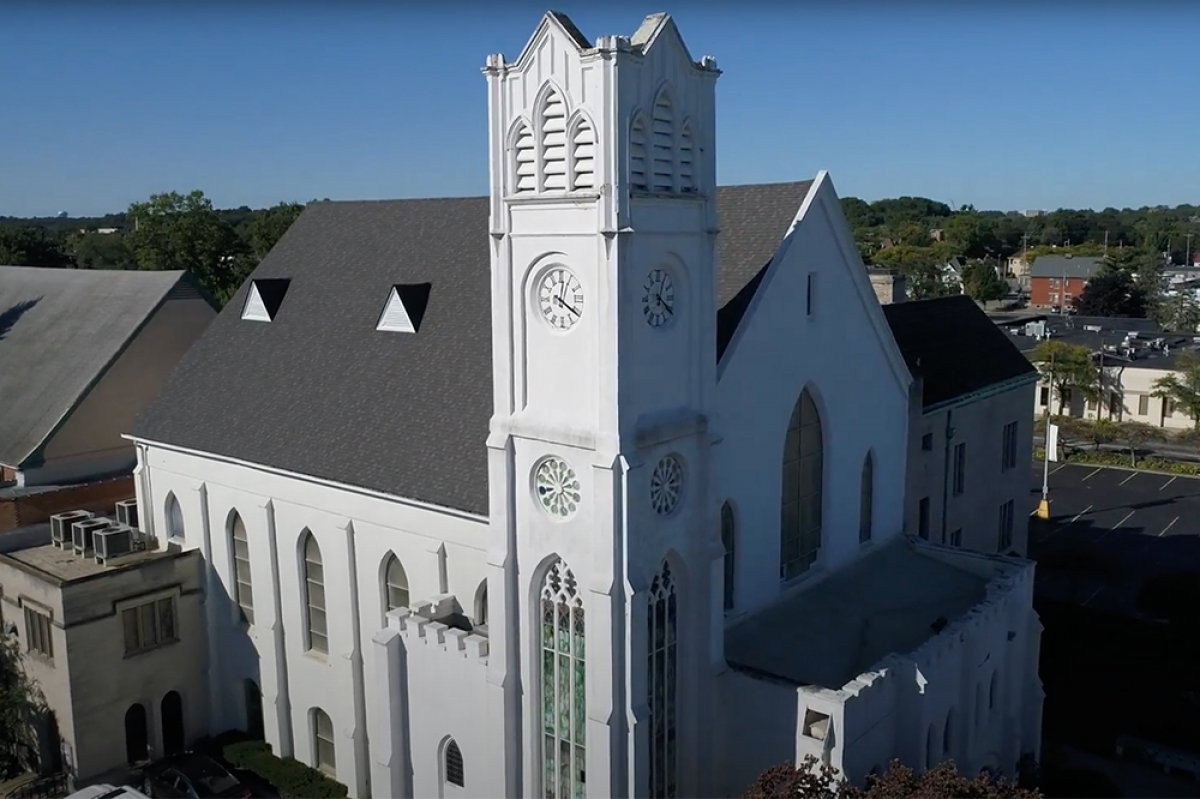“As always, our church is in God’s hands, and as long as we’re open to where God is leading us, we see hope for the future and good things happening.”
- Rev. Dr. David L. Nichols
Our History
The Baptist faith reached this portion of the Michigan Territory in 1826 when a missionary preached to the Potawatomie living in this area. In 1836, a year before Michigan became a state, fourteen settlers met in a frontier home to organize the First Baptist Church. The current church building was erected in 1853, and modified in 1871 with a gabled roof and a balcony to keep the walls from bowing out. This unique solution has worked for nearly 150 years and the sanctuary remains a place of beauty for worship and concerts. In 1931, a four-story facility with a basement was added to accommodate the growing children’s program. (Read more about our rich historic past in this article from the Kalamazoo Public Library)
Like many older downtown churches, First Baptist faced struggles in recent decades. In fact, declining attendance and growing operating deficits brought the church to the brink of closing in January 2015. But the church instead voted to spend its accumulated funds to do something new and different. This led to the hiring of Rev. Dr. David L. Nichols and a bold plan to share the building with nonprofit organizations.
Amazing things have happened since that landmark decision, and First Baptist now enjoys a rich, sustaining community life through the work of the Kalamazoo Nonprofit Advocacy Coalition - KNAC, housed and thriving within the walls of our historic building. KNAC’s vision is to provide affordable spaces and services for the arts, startups, and community organizations to prosper, while preserving the beauty of downtown Kalamazoo and assuring sustainability of the historic First Baptist Church building to celebrate the arts and enhance the livelihood and culture of Kalamazoo.
First Baptist c1871-1884
Interior of First Baptist Church, Dedication of the Sanctuary, 30 December 1951. Kalamazoo Public Library Photograph P-770
The First Baptist Church congregation have recently donated our building to KNAC. Along with this gift comes the responsibility for KNAC not only to manage the building and its users, but to also maintain and upgrade it in ways that will keep FBC a central feature of Kalamazoo for decades to come.
Musical Heritage
Throughout our weekend service, we are surrounded by beauty as we listen to the glorious music of our Letourneau Organ and Fazioli Piano - rich musical features of our historic church and the greater Kalamazoo community.
Fazioli Piano
The Fazioli 9'2" concert grand piano is a special addition to the life of First Baptist Church in downtown Kalamazoo and to the area arts scene.
It is the first Fazioli piano in Michigan and the first in a church setting in the United States. Prior to its arrival in Kalamazoo, the instrument was used for concerts in northern Europe and England.
The inaugural public performance in Kalamazoo occurred on Saturday, April 13, 2002, just four days after the piano's arrival, when Paul Nitsch joined the Cavani String Quartet in a Fontana Chamber Arts concert. The ensemble played the Dvorak Piano Quintet in A Major, Op. 81. The Fazioli piano has since been utilized in over 40 events, which have occurred through the Community Arts Program at First Baptist.
The Fazioli piano company, located about 35 miles north east of Venice, Italy, was founded in 1981 by Paolo Fazioli. With professional training in mechanical engineering and piano performance, he set out to produce a new professional grand piano with a distinct sound quality. The pianos feature sounding boards made from a resonant spruce from the forests of Val de Fiemme where Stradivarius sought wood for his violins.
LeTourneau Organ
This instrument includes the first full-length metal 32-foot reed stop built by Orgues Letourneau. (They have built four 32-foot metal reeds of half-length.) Forty artisans who worked on this instrument range in age from 18 to 64; more than half have Letourneau organ building as their first and only career.
Fewer than 3% of the total number of pipes are visible from the pews; the others are behind the facade of the organ case. The 3,638 pipes constitute a small proportion of the roughly 100,000 wood, metal, and other components of the organ. Each large facade pipe required the efforts of two men a full day to polish it.
The largest 24 pipes of the 32-foot reed and the largest 12 pipes of all the sixteen-foot reeds have boots made of wood for endurance and stability over the decades; the largest 12 pipes of all the sixteen-foot metal ranks have double-thick metal in the foot to support the pipe's weight in coming generations.
The most important "stop" on any organ is the room in which it is placed; the last and most important 30% of pipe voicing is done on site to fit the room's acoustics.
Custom-designed, each organ is completely erected and playable in the builder's shop before it is disassembled and shipped for installation. After most parts were already made, erecting this organ in the shop took four months; re-erecting it in the church took three weeks.
Pipes and other parts were transported from the shop to the church in two fully packed 47-foot semi-trailers. The largest pipes weigh 450 pounds, the smallest less than a pencil. The whole organ weighs about twelve tons.







